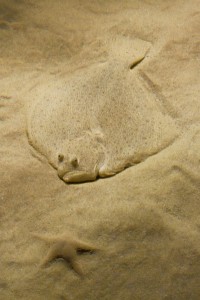Fishing the Coastal Gulf of Mexico for the Southern Flounder
As coastal fishermen along the entire Coast of the Gulf of Mexico check off the last day of  August they start seeing visions of saddle blanket flounder. That’s what we call them here in Texas. In Florida they call them doormat flounder. Whatever the locals call them, Paralichthys Lethostigma or the Southern Flounder is about the best eating fish that can be caught in the coastal waters of the Gulf of Mexico.
August they start seeing visions of saddle blanket flounder. That’s what we call them here in Texas. In Florida they call them doormat flounder. Whatever the locals call them, Paralichthys Lethostigma or the Southern Flounder is about the best eating fish that can be caught in the coastal waters of the Gulf of Mexico.
The Southern Flounder just may be best when broiled with lemon juice and a generous portion of butter. Fall can’t get here fast enough.
Flounder migration runs from roughly September to November here on the Gulf of Mexico coast. Flounder catch numbers have been going up along the entire gulf coast due to excellent resource management. Fishing and wildlife conservation organizations such as my states Texas Parks and Wildlife, and the Coastal Conservation Association, or CCA, have done so much to raise awareness of flounder growth habits, flounder habitat, and flounder migration. Most important is the realization that the first generation of flounder stay in inlets, bays, and estuaries of the Gulf of Mexico until they have reached a size suiting the environment of the open Gulf. When the young flounder are large enough they migrate out to the open Gulf so they can breed. Size limits and possession limits have done much to increase the population of this excellent food fish.
Light bait casting or spinning tackle designed for speckled trout, small redfish, or salt water pan fish work well. A 7 foot light spin casting or bait casting rod teamed with a reel that handles lighter lines is perfect. Circle hooks work wonderfully since they are almost impossible to swallow. Many gulf coast fishermen use 4/0 circle hooks teamed with a couple of feet of 30 lb test monofilament leader on 14 pound test line for the flounder. Use just enough weight between the line and leader to get the bait to the bottom.
Mud Minnows and finger mullet from two to three inches long make the best bait. If these bait fish species cannot be found in your favorite bait camp use a cast net to grab plenty of bait out of the shallows.
Flounder are ambush feeders. They like to wait for food to come to them. So they like to feed on an outgoing tide on the downstream side of structure like pilings, rocks and points of land. Work the outgoing, moving tide where the flounder lay in an eddy waiting for food to come to them. Move the bait very slowly. Docks and piers located in a moving, outgoing tide are wonderful places for bank fishing.
Flounders have a very light strike. What you will feel is much like the bait has been caught on structure. There will be a small amount of pressure on the line. They take the bait and hold it for a short while sometimes swimming with it to a safety zone. When using a circle hook set the hook by just lightly raising the rod tip while reeling the line in. The circle hook will do all the work for you.
Fishing the inlets, estuaries and bays of the coastal Gulf of Mexico for the Southern Flounder is productive, fun and downright delicious. Don’t let the fall get away from you without wetting a line in good flounder habitat.
